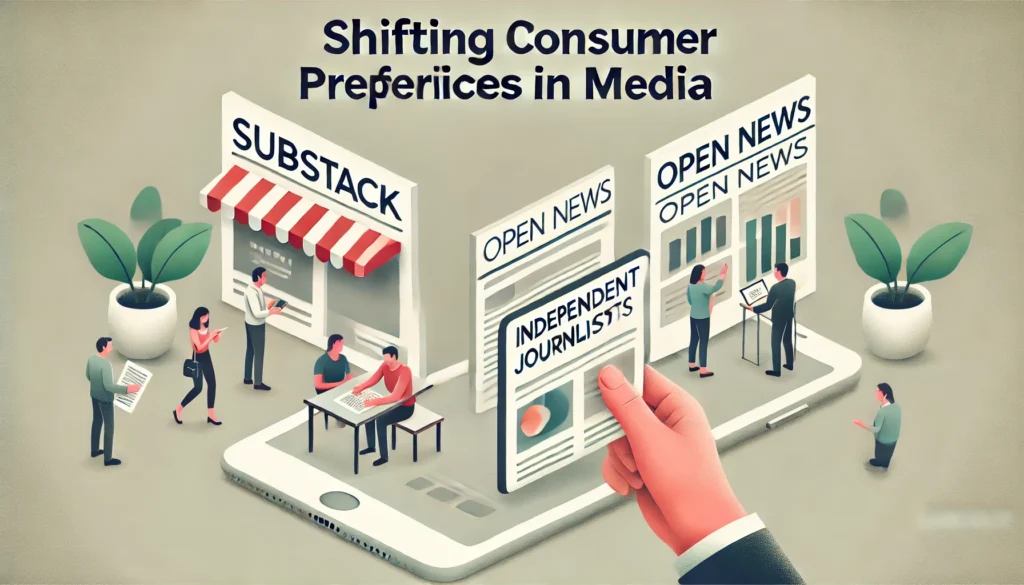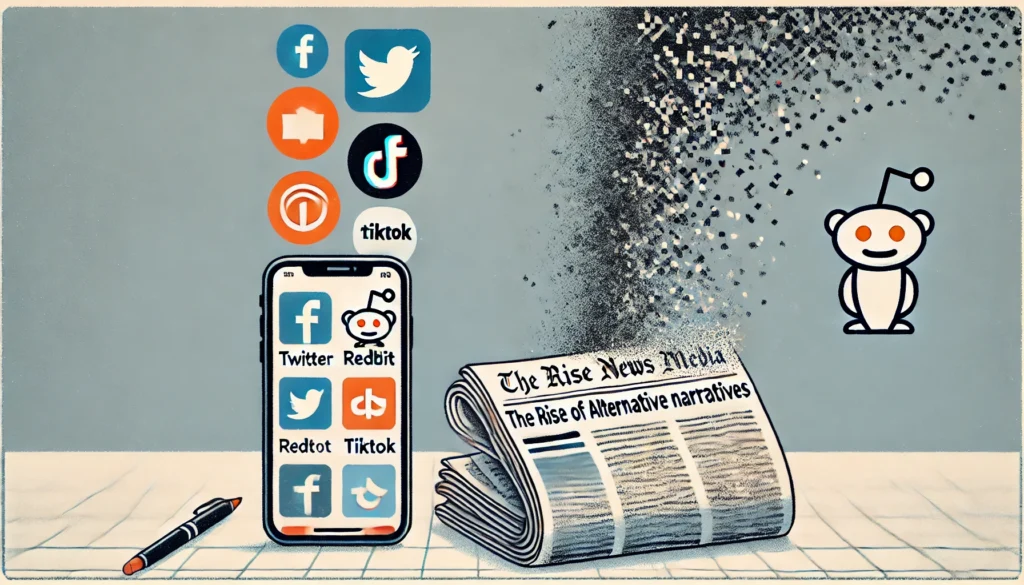

Blog
Why Many Are No Longer a Fan of NYT: Examining the Shift in 2024
In 2024, there is a growing sentiment among readers who are no longer a fan of NYT (The New York Times). Once heralded as the gold standard in journalism, the NYT now faces increasing criticism from readers across the globe. This shift has sparked conversations about the broader role of mainstream media and how trusted sources of news may have lost the confidence of a large portion of their audience. So, why are so many readers abandoning their long-standing loyalty to the NYT? In this article, we’ll explore the reasons behind this shift, touching on the evolving media landscape, reader dissatisfaction, and changing journalistic practices.
The Changing Face of Journalism
Contents

1. Perceived Political Bias
One of the main reasons why many are no longer a fan of NYT in 2024 is the perception that the newspaper has increasingly leaned into political bias. While no media outlet is immune to bias, many long-time readers argue that the NYT has shifted away from balanced reporting, particularly in its coverage of political issues.
This shift has alienated a significant segment of readers who feel that the publication’s content now caters to a specific ideological stance, rather than presenting diverse perspectives. As trust in media declines, the NYT’s perceived bias has become a focal point for critics, driving many to seek alternative sources of news.
2. Overemphasis on Opinion Pieces
In recent years, the NYT has ramped up the volume of opinion content, which some readers argue comes at the expense of hard news reporting. While opinion pieces can provide valuable insight, they are often seen as less fact-driven and more prone to promoting subjective viewpoints.
Many readers, once loyal to the NYT for its in-depth reporting, find themselves frustrated by the blurred line between opinion and news, further fueling their decision to disengage from the publication.
Shifting Consumer Preferences in Media

1. Rise of Independent Journalism
The rise of independent journalism platforms such as Substack, Patreon, and other reader-funded outlets has significantly altered the media landscape. Independent journalists, no longer bound by corporate editorial policies, have built strong followings by offering content that readers find more authentic and unbiased compared to mainstream media like the NYT.
In 2024, a significant portion of readers are no longer a fan of NYT because they feel these independent platforms better reflect their views and offer a more balanced take on current events.
2. Preference for Digital-First News Platforms
Today’s consumers increasingly prefer fast, digestible news content that is readily available on digital platforms. While the NYT has a strong digital presence, it has faced criticism for its subscription-based paywall, which limits access to articles for non-subscribers. As a result, younger audiences, who are less willing to pay for content, have turned to free news alternatives.
This shift in consumer behavior has contributed to the trend of people moving away from traditional news sources like the NYT in favor of digital-native platforms that prioritize accessibility and convenience.
Impact of Subscription Models and Paywalls

1. The Frustration with Paywalls
Many readers who are no longer a fan of NYT cite frustration with the newspaper’s paywall model. With the NYT increasingly relying on subscription revenue, the paywall has become a barrier for casual readers or those unwilling to commit to a monthly fee. While supporters argue that quality journalism requires financial backing, others feel that information should remain accessible to all, especially in the digital age.
This tension between quality content and accessibility has led some readers to abandon the NYT in favor of free-to-read platforms, which often offer similar news coverage without financial restrictions.
2. Subscription Fatigue
In 2024, subscription fatigue is a real phenomenon. With consumers already paying for multiple streaming services, news subscriptions like the NYT are often viewed as an additional, unnecessary expense. This growing reluctance to subscribe to yet another service has led many to reevaluate their relationship with the NYT and other paywalled news outlets.
As more readers opt out of paid news services, the trend of disengaging from traditional publications continues to rise, pushing people toward alternative, often free, sources of information.
Concerns About Editorial Standards
1. Sensationalism in Headlines
Sensationalist headlines have become a growing concern for readers who value journalistic integrity. Critics argue that the NYT has occasionally prioritized eye-catching headlines over substantive content in an effort to drive clicks and increase digital engagement. This shift toward a more click-driven approach has left some readers feeling disillusioned, leading them to seek out news outlets that prioritize depth over sensationalism.
2. Corrections and Accountability
Another reason readers are no longer a fan of NYT is dissatisfaction with the way the newspaper handles corrections and accountability. In a fast-paced news cycle, mistakes are inevitable, but critics argue that the NYT’s correction process can sometimes lack transparency. For readers who prioritize accuracy and accountability, this has become a sticking point, further eroding their trust in the publication.
The Rise of Alternative Narratives
1. Misinformation and Polarization
The information age has ushered in an era of increased misinformation, and many readers blame mainstream media outlets, including the NYT, for contributing to the polarization of public discourse. Some argue that the NYT has become part of a larger echo chamber, reinforcing existing biases rather than challenging them with objective, balanced reporting.

This growing distrust in mainstream media has driven a large number of readers toward alternative news sources that claim to offer a more balanced and less polarizing view of the world.
2. Social Media Influence
Platforms like Twitter (now X), Reddit, and TikTok have democratized the news landscape, allowing anyone with a smartphone to share information instantly. Many younger readers, in particular, are turning to social media for their news, where stories often come from a wide variety of voices and perspectives.
For those who no longer a fan of NYT, social media provides an appealing alternative to traditional journalism, offering a diversity of viewpoints that the NYT, in their view, no longer delivers.
Conclusion
The reasons why many are no longer a fan of NYT in 2024 are diverse and multifaceted. From perceived political bias and an overemphasis on opinion content to frustration with paywalls and sensationalist headlines, readers have grown increasingly critical of the once-revered publication. Additionally, the rise of independent journalism, digital-first news platforms, and social media has offered readers more options than ever before, making it easier to disengage from traditional outlets like the NYT.
As the media landscape continues to evolve, it remains to be seen how the NYT and other mainstream publications will adapt to regain the trust and loyalty of their readers. However, the current trend suggests that a growing segment of the population is seeking out alternative news sources that better align with their preferences for accessible, unbiased, and transparent reporting.
Before you go, check out our latest article: What is ArmorThane 30 Years: A Look at 3 Decades of Innovation in Protective Coatings
Blog
What is Consortium Enterprises Navoou? Understanding This Collaborative Business Model

Contents
- 1 Introduction to Consortium Enterprises Navoou
- 2 Key Features of Consortium Enterprises Navoou
- 3 Benefits of Consortium Enterprises Navoou
- 4 Quick Tips for Maximizing Participation in Consortium Enterprises Navoou
- 5 Pros and Cons of Consortium Enterprises Navoou
- 6 Key Terms in Consortium Enterprises Navoou
- 7 Highlighted Statistics on Collaborative Business Models
- 8 Comparison: Consortium Enterprises Navoou vs. Traditional Business Alliances
- 9 Frequently Asked Questions
- 10 Conclusion
Consortium Enterprises Navoou is a forward-thinking approach to business collaboration that enables multiple companies to pool resources, share expertise, and work together to achieve mutual goals. This consortium model emphasizes adaptability, strategic alignment, and a flexible structure, making it well-suited for navigating today’s fast-paced market conditions. By uniting under a shared mission, member organizations gain competitive advantages, such as expanded market access and risk reduction.
Strategic Collaboration
The core of Consortium Enterprises Navoou lies in its collaborative governance model, which ensures that each member organization has a voice in decision-making:
- Shared Resources: Companies pool resources, such as technology and expertise, to address complex challenges efficiently.
- Inclusive Decision-Making: Collaborative governance allows all members to participate in forming strategies, fostering trust and alignment.
- Joint Initiatives: By combining capabilities, member companies execute large-scale projects that may be challenging individually.
Flexible Structure
Flexibility is integral to Consortium Enterprises Navoou as it adapts to changing market demands and conditions:
- Scalability: The consortium can adjust its operations and resource allocation based on current needs.
- Market Responsiveness: This adaptability enables the consortium to pivot strategies quickly, remaining competitive in dynamic environments.
Joining Consortium Enterprises Navoou provides significant advantages for member organizations:
- Enhanced Innovation: Shared knowledge and expertise drive new ideas and solutions.
- Reduced Investment Risks: By sharing costs, companies lower individual financial burdens and risks.
- Faster Market Entry: Member organizations access new markets collectively, streamlining distribution and marketing efforts.
- Competitive Edge: Collaboration improves efficiency, providing a strong advantage over competitors.
- Leverage Shared Resources: Make use of pooled resources for research and development to innovate more effectively.
- Engage in Collaborative Decision-Making: Actively participate in governance to contribute valuable insights and foster cooperation.
- Stay Adaptable: Be open to shifting strategies based on market changes to maintain competitiveness.
| Pros | Cons |
|---|---|
| Access to shared resources and expertise | Potential for conflicts in decision-making |
| Risk reduction through collective investment | Requires high levels of communication |
| Scalability and adaptability | May limit autonomy for individual companies |
| Fast market entry with shared channels | Joint projects can be complex to manage |
- Consortium: A collaborative alliance of companies working toward shared objectives.
- Collaborative Governance: A management model where all member organizations participate in decision-making.
- Flexible Structure: An adaptable organizational framework that adjusts to market needs.
Highlighted Statistics on Collaborative Business Models
- Increased Efficiency: Studies show that organizations in consortiums can achieve up to 40% greater efficiency in joint projects.
- Risk Reduction: Collective investment reduces individual risks by an average of 25%.
- Faster Market Entry: Companies entering markets through consortiums can accelerate entry by up to 30%.
| Aspect | Consortium Enterprises Navoou | Traditional Business Alliance |
|---|---|---|
| Governance Structure | Collaborative governance, all members have a say | Often hierarchical with limited input |
| Adaptability | Highly adaptable, scales as needed | Typically less flexible |
| Risk Distribution | Risks shared across members | Risk remains higher for individual organizations |
| Market Entry Speed | Accelerated through shared channels | Slower, as each member may manage their own entry |
Frequently Asked Questions
What is Consortium Enterprises Navoou?
Consortium Enterprises Navoou is a collaborative business model where companies pool resources, expertise, and decision-making to achieve shared objectives and tackle complex challenges.
How does Consortium Enterprises Navoou benefit member companies?
Member companies gain advantages like reduced investment risks, faster market entry, shared innovation, and a competitive edge through collaboration.
What types of businesses can join Consortium Enterprises Navoou?
Companies from diverse industries can participate, especially those looking to innovate, reduce risks, and expand market access through strategic collaboration.
Is there a downside to the Consortium Enterprises Navoou model?
While beneficial, this model requires high levels of communication and cooperation, and some companies may find collaborative governance challenging.
Conclusion
The Consortium Enterprises Navoou model exemplifies a modern approach to business collaboration, enabling companies to pool resources and share expertise for mutual gain. By fostering innovation, reducing risks, and enhancing flexibility, this consortium provides a competitive advantage for organizations in today’s fast-changing business landscape. Understanding and participating in such collaborative models can pave the way for successful partnerships and accelerated growth. Note: This article is for informational purposes only.
Blog
What is 561BRS? Exploring its Uses in Legal Services, Retail, and Music Technology

Introduction to 561BRS
Contents
- 1 Introduction to 561BRS
- 2 Applications of 561BRS Across Different Sectors
- 3 Benefits of Understanding the Context of 561BRS
- 4 Quick Tips for Using 561BRS
- 5 Pros and Cons of 561BRS in Different Applications
- 6 Key Terms in 561BRS Contexts
- 7 Highlighted Statistics on 561BRS
- 8 Comparison: 561BRS in Legal, Retail, and Music Technology
- 9 Frequently Asked Questions
- 10 Conclusion
What is 561BRS? This term has surfaced in diverse fields, from legal services and retail management to music technology. Each context presents a unique function for 561BRS, reflecting its versatility across industries. Understanding its meaning relies on the specific setting in which it’s used.
Applications of 561BRS Across Different Sectors
561BRS in Legal Services
In the legal realm, 561BRS refers to a legal team specializing in various practice areas:
- Comprehensive Legal Services: This team handles criminal defense, family law, personal injury, corporate law, and estate planning.
- Personalized Client Approaches: Emphasizes tailoring strategies to meet individual needs, ensuring a client-focused experience.
- Expert Guidance: Provides clients with clarity and support through complex legal processes.
561BRS as a Product Code in Retail
In retail and inventory management, 561BRS serves as a unique product identifier:
- Inventory Management: Essential for organizing and tracking products, minimizing errors in stock management.
- Customer Convenience: Allows consumers to quickly locate and identify products, improving the shopping experience.
- Operational Efficiency: Streamlines operations by simplifying product organization and retrieval.
561BRS in Music and Technology Integration
In music technology, 561BRS refers to a tool that merges music creation with technology:
- Music Production Simplification: Designed to make the music production process accessible to both novices and professionals.
- Advanced Algorithms: Uses technology to automate complex tasks, allowing musicians to focus on creativity.
- User-Friendly Interface: Encourages exploration and creativity in music production with easy-to-use tools.
Benefits of Understanding the Context of 561BRS
- Enhanced Clarity: Knowing the specific industry application helps understand the exact function of 561BRS.
- Improved Decision-Making: Assists users in choosing the correct application, whether for legal advice, product identification, or music production.
- Efficient Problem-Solving: Each context offers tailored solutions—legal assistance, product management, or creative tools.
Quick Tips for Using 561BRS
- Identify the Context: Determine if 561BRS refers to legal, retail, or music technology before use.
- Utilize Appropriately: Use it as a product code in retail or as a tool in music production as intended.
- Seek Professional Advice in Legal Services: Consult the 561BRS legal team for specialized assistance based on your needs.
Pros and Cons of 561BRS in Different Applications
| Sector | Pros | Cons |
|---|---|---|
| Legal Services | Personalized, diverse expertise | Fees may vary based on service |
| Retail Identification | Streamlines inventory, enhances experience | Limited information on product details |
| Music Technology | Simplifies music creation, user-friendly | May lack features for advanced users |
Key Terms in 561BRS Contexts
- Product Code: A unique identifier assigned to products for inventory management.
- Music Production Tool: Software or device designed to aid in creating and editing music.
- Legal Services: Professional assistance in areas like criminal defense, family law, and corporate law.
Highlighted Statistics on 561BRS
- Legal Sector Popularity: A growing number of clients seek specialized legal teams like 561BRS for tailored services.
- Retail Efficiency: Using product codes like 561BRS can reduce inventory errors by up to 30%.
- Music Production Growth: Demand for user-friendly tools like 561BRS has increased by 40% in recent years.
Comparison: 561BRS in Legal, Retail, and Music Technology
| Feature | Legal Services (561BRS) | Retail Product Code (561BRS) | Music Technology Tool (561BRS) |
|---|---|---|---|
| Purpose | Provides legal expertise | Organizes and tracks products | Simplifies music creation |
| User Benefit | Tailored support, peace of mind | Easy product identification | Accessible music production tools |
| Complexity | High, requires professional guidance | Moderate, improves inventory management | Moderate, intuitive for beginners |
Frequently Asked Questions
What is 561BRS in legal services?
561BRS refers to a legal team offering comprehensive services in areas like criminal defense, family law, and corporate law, with a focus on personalized client support.
How is 561BRS used in retail?
In retail, 561BRS serves as a product code, streamlining inventory management and helping customers quickly identify specific items.
What does 561BRS represent in music technology?
561BRS is an innovative tool that combines music production with advanced technology, simplifying complex tasks for musicians of all levels.
Does the meaning of 561BRS change depending on the context?
Yes, 561BRS has varied meanings in legal services, retail, and music technology, each with unique applications and purposes.
Conclusion
The term 561BRS demonstrates its versatility across different sectors, from legal services to retail and music technology. Each interpretation provides valuable applications, whether through legal support, efficient product tracking, or creative tools for musicians. Understanding its context is essential to using 561BRS effectively.
Blog
What is the Korean GG Auction Cup Sumire? Exploring Sumire Nakamura’s Impact in the 18th Korean GG Auction Cup

Introduction to the Korean GG Auction Cup Sumire
Contents
- 1 Introduction to the Korean GG Auction Cup Sumire
- 2 Sumire Nakamura’s Journey in the 18th Korean GG Auction Cup
- 3 Key Features of the Korean GG Auction Cup
- 4 Benefits of Participating in the Korean GG Auction Cup
- 5 Quick Tips for Aspiring Go Players
- 6 Pros and Cons of the Korean GG Auction Cup Format
- 7 Key Terms in the Korean GG Auction Cup
- 8 Highlighted Statistics on the Korean GG Auction Cup
- 9 Comparison: Korean GG Auction Cup vs. Traditional Go Tournaments
- 10 Frequently Asked Questions
- 11 Conclusion
The Korean GG Auction Cup Sumire brings attention to the remarkable achievements of Sumire Nakamura, a young Go player from Japan, in the 18th Korean GG Auction Cup. This annual tournament adopts a “win-and-continue” format where top female players face off against senior male professionals. Nakamura’s participation in the 2024 edition highlights her commitment to challenging herself on an international stage, as she seeks to gain experience and develop her skills in South Korea, known for its elite Go community.
Sumire Nakamura’s Journey in the 18th Korean GG Auction Cup
Sumire Nakamura’s progress in the Korean GG Auction Cup has been marked by key victories and notable performances:
- June 24, 2024: Nakamura defeated Yue Liang 6p, winning by a close margin of 2.5 points.
- June 25, 2024: She continued her winning streak by defeating Choi Wongyong 6p through a resignation win.
- July 1, 2024: Nakamura’s winning streak ended with a loss by resignation to Yang Keon 9p.
These matches underscore her skill and adaptability, proving her competitive edge even among seasoned players.
Key Features of the Korean GG Auction Cup
The Korean GG Auction Cup is a unique tournament with a distinct format and purpose:
Win-and-Continue Format
The “win-and-continue” structure allows players to remain in the tournament as long as they continue to win, creating an intense, progressive competition.
- Team-Based Play: Female professionals compete against senior male professionals in a team format.
- High Stakes: Each victory allows players to continue, adding pressure to each game.
- Showcasing Talent: This format highlights both rising stars and experienced players.
International Participation and Recognition
Nakamura’s involvement illustrates the tournament’s growing influence in the international Go community:
- Cross-Cultural Competitiveness: Players from various countries join to showcase their skills.
- Platform for Emerging Talent: Young players like Nakamura use the tournament as a learning experience.
Benefits of Participating in the Korean GG Auction Cup
For players like Sumire Nakamura, participation in the Korean GG Auction Cup provides various benefits:
- Skill Development: Competing with seasoned players sharpens skills and enhances strategic thinking.
- Cultural Exchange: Interacting with international players fosters understanding and appreciation of different playing styles.
- Exposure and Experience: Young talents gain valuable experience in high-stakes tournaments.
Quick Tips for Aspiring Go Players
- Study Tournament Formats: Understanding unique structures like “win-and-continue” can improve adaptability in matches.
- Watch High-Level Games: Observing top players in tournaments like the GG Auction Cup offers insights into advanced strategies.
- Embrace International Play: Exposure to different playing styles enhances flexibility and growth in Go.
Pros and Cons of the Korean GG Auction Cup Format
| Pros | Cons |
|---|---|
| Highlights both emerging and senior talent | High-pressure format may be challenging for some |
| Unique structure showcases diverse skills | Win-and-continue may limit exposure for some players |
| Encourages international participation | Potentially high travel costs for participants |
Key Terms in the Korean GG Auction Cup
- Win-and-Continue Format: A tournament structure where players remain in competition as long as they continue winning.
- 6p/9p (Dan Levels): Go ranking levels indicating player proficiency, with higher numbers representing more experience and skill.
- Resignation Win: A type of victory in Go where the opponent concedes due to a perceived or certain loss.
Highlighted Statistics on the Korean GG Auction Cup
- Year of Inception: The Korean GG Auction Cup has been held annually since its inception.
- 18th Edition: The 2024 tournament marks the 18th edition of the cup.
- Sumire’s Wins: Notable victories in 2024 against high-ranking players such as Yue Liang 6p and Choi Wongyong 6p.
Comparison: Korean GG Auction Cup vs. Traditional Go Tournaments
| Feature | Korean GG Auction Cup | Traditional Go Tournaments |
|---|---|---|
| Tournament Format | Win-and-continue | Varies, often round-robin or elimination |
| Gender and Age Diversity | Female pros vs. senior male professionals | Mixed or separate categories by tournament |
| International Participation | Increasing, drawing players from various countries | Often limited to specific regions |
| Emphasis on Emerging Talent | High, offering a platform for young players | Varies depending on tournament structure |
Frequently Asked Questions
What is the purpose of the Korean GG Auction Cup?
The Korean GG Auction Cup provides a unique platform for showcasing both emerging female talent and experienced senior male professionals in a win-and-continue format.
How did Sumire Nakamura perform in the 18th Korean GG Auction Cup?
Sumire Nakamura won two matches in the 2024 tournament against Yue Liang 6p and Choi Wongyong 6p, before her winning streak ended against Yang Keon 9p.
Why did Sumire Nakamura move to South Korea?
Nakamura moved to South Korea in 2023 to improve her skills by competing against stronger opponents and immersing herself in the country’s renowned Go culture.
What benefits does a player gain from competing in the Korean GG Auction Cup?
Players gain valuable experience, exposure, and the opportunity to develop their skills in a high-stakes, internationally recognized tournament.
Conclusion
The Korean GG Auction Cup Sumire refers to Sumire Nakamura’s inspiring performances in the 18th edition of this prestigious Go tournament. Her participation highlights both her commitment to growth and the Korean GG Auction Cup’s role in fostering competitive development among young Go players. By providing a unique win-and-continue structure, the tournament brings together diverse talents, creating an engaging and impactful experience in the world of Go. Note: This article is for informational purposes only.






